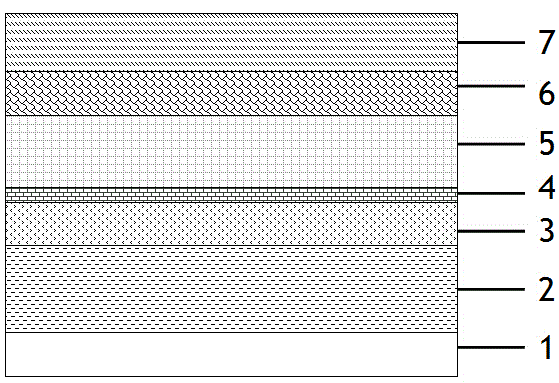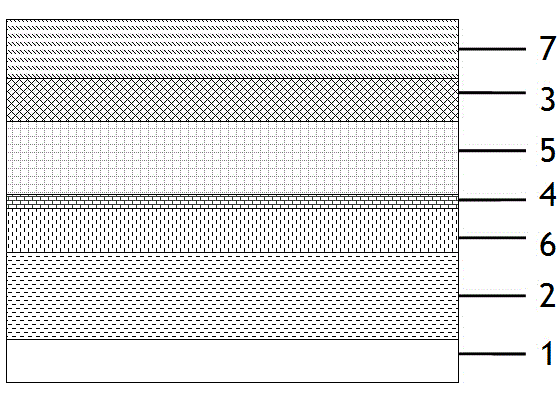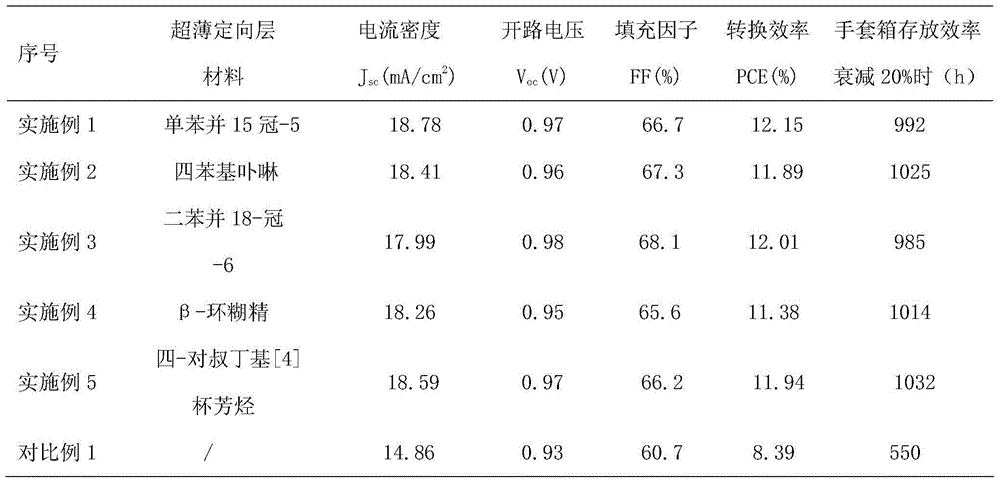Organic and inorganic hybrid perovskite-based solar cell and method for manufacturing same
A solar cell and perovskite technology, applied in circuits, photovoltaic power generation, electrical components, etc., can solve the problems of difficult control of crystal quality, poor regularity, and many crystal defects, so as to improve photoelectric conversion efficiency and stability, and improve Crystal regularity and the effect of increasing the diffusion length
- Summary
- Abstract
- Description
- Claims
- Application Information
AI Technical Summary
Problems solved by technology
Method used
Image
Examples
preparation example Construction
[0037] figure 1 In the organic-inorganic hybrid perovskite-based solar cell shown, before the perovskite light-absorbing layer is prepared by the liquid phase method, the surface of the electron transport layer is modified with a micro-nano structure to form an ultra-thin alignment layer. The preparation method includes the following steps :
[0038] 1) Clean the transparent electrode, etch the electrode pattern and then clean, dry, and UV / ozone treatment;
[0039] 2) preparing an electron transport layer on the transparent electrode;
[0040] 3) Perform interface modification on the surface of the electron transport layer to form an ultra-thin alignment layer;
[0041] 4) On the surface of the ultra-thin alignment layer, grow a perovskite light-absorbing layer;
[0042]5) Depositing a hole transport layer on the surface of the perovskite light-absorbing layer;
[0043] 6) Prepare a counter electrode on the hole transport layer.
[0044] figure 2 In the organic-inorgani...
Embodiment 1
[0065] The first step is to prepare a transparent electrode:
[0066] The ITO conductive glass was etched with concentrated hydrochloric acid to form an electrode pattern, and then ultrasonically cleaned with detergent, deionized water, absolute ethanol, acetone, and isopropanol for 10 minutes, then dried with nitrogen, and treated with UV / ozone for 20 minutes.
[0067] The second step is to prepare the electron transport layer:
[0068] Coating nano-TiO on the surface of transparent electrode by screen printing method 2 The precursor solution of the particle colloid is then put into a muffle furnace for sintering at a high temperature of 450° C. for 30 minutes to form an electron transport layer with a thickness of 45 nm.
[0069] The third step is to prepare an ultra-thin alignment layer:
[0070] Uniformly dispersing the monobenzo-15-crown-5 cyclic molecular material with a mass fraction of 1% in a chloroform solvent with a mass fraction of 99% to prepare a transparent an...
Embodiment 2
[0081] Except for the third step, the preparation method of other steps is the same as that of Example 1.
[0082] The third step is to prepare an ultra-thin alignment layer:
[0083] Uniformly dispersing the tetraphenylporphyrin ring molecular material with a mass fraction of 0.5% in a dichloromethane solvent with a mass fraction of 99.5% to prepare a transparent and uniform ultra-thin alignment layer solution;
[0084] Form the above prepared solution on the surface of the electron transport layer by spin-coating to form a film with a thickness of 2nm;
[0085] The film prepared above was dried in air at 60° C. for 90 minutes to form an ultra-thin alignment layer.
[0086] The device structure of organic-inorganic hybrid perovskite-based solar cells prepared by the above method is as follows: figure 1 Shown: G / ITO / TiO 2 / Tetraphenylporphyrin / CH 3 NH 3 PB 3 / spiro-OMeTAD / Au with an effective area of 0.09cm 2 , the photoelectric conversion efficiency data are shown in T...
PUM
| Property | Measurement | Unit |
|---|---|---|
| Thickness | aaaaa | aaaaa |
| Thickness | aaaaa | aaaaa |
| Thickness | aaaaa | aaaaa |
Abstract
Description
Claims
Application Information
 Login to View More
Login to View More - R&D
- Intellectual Property
- Life Sciences
- Materials
- Tech Scout
- Unparalleled Data Quality
- Higher Quality Content
- 60% Fewer Hallucinations
Browse by: Latest US Patents, China's latest patents, Technical Efficacy Thesaurus, Application Domain, Technology Topic, Popular Technical Reports.
© 2025 PatSnap. All rights reserved.Legal|Privacy policy|Modern Slavery Act Transparency Statement|Sitemap|About US| Contact US: help@patsnap.com



